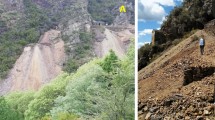Abstract
Tailings, agricultural soils, vegetables and groundwater samples were collected from abandoned metal mines (Duckum, Dongil, Dongjung, Myoungbong and Songchun mines) in Korea. Total concentrations of arsenic (As) and heavy metals (Cd, Cu, Pb and Zn) were analyzed to investigate the contamination level. Several digestion methods (Toxicity characteristics leaching procedure (TCLP), synthetic precipitation leaching procedure (SPLP), 0.1 N/1 N HCl) and sequential extraction analysis for mine tailings were conducted to examine the potential leachability of As and heavy metals from the tailings. The order of urgent remediation for the studied mines based on the risk assessment and remedial goals was suggested.
The Songchun mine tailings were most severely contaminated by As and heavy metals. Total concentrations of As and Pb in the tailings were 38,600–58,700 mg/kg (av. 47,400 mg/kg) and 11,800–16,800 mg/kg (av. 14,600 mg/kg), respectively. Agricultural soils having high As concentrations were found at the all mines. Average concentrations of Cd in the vegetables exceeded the normal value at all mines areas, while As only at the Dongjung, Myoungbong, and Songchun mine area. One groundwater sample each from the Dongil and Myoungbong mines, and 4 groundwater samples from the Songchun mine had values above 10 μg/L of As concentration.
The TCLP method revealed that only Pb in the Songchun tailings, 6.49 mg/L, exceeded the regulatory level (5 mg/L). Employing the 1-N HCl digestion method, the concentration of As in the Songchun mine tailings, 4,250 mg/kg, was up to 3,000 times higher than its Korean countermeasure standard. Results from the sequential extraction of As in the tailings showed that the easily releasable fraction in the Myoungbong and Songchun mine tailings was more than 30% and the residual fraction was less than 40%.
Based on results showing the exposure health risk employing the hazard quotient and cancer risk of As, Cd and Zn, the Dongil mine needs the most urgent remedial action. The concentration reduction factor (CRF) of As in both soil and groundwater follows the order: Songchun>Dongjung>Dongil>Myoungbong>Duckum mine.
Similar content being viewed by others
References
DC. Adriano (1986) Trace Elements in the Terrestrial Environment Springer-Verlag New York Inc
O Aslibekian R. Moles (2003) ArticleTitleEnvironmental risk assessment of metals contaminated soils at silvermines abandoned mine site, Co Tipperary, Ireland Environ Geochem Health 25 247–266 Occurrence Handle10.1023/A:1023251102402
InstitutionalAuthorNameASTM (American Society for Testing and Materials) (1995) Standard Guide for Risk-Based Corrective Action Applied at Petroleum Release Sites Annual book of ASTM standards Philadelphia, PA
ASTM (American Society for Testing and Materials) 1998. Standard Guide for Risk-based Corrective Action. Philadelphia, PA: ASTM PS-104.
HJM. Bowen (1979) Environmental Chemistry of Elements Academic Press London
W.K. Fletcher (1981) Handbook of Exploration Geochemistry 1 Elsevier Science Publishers B.V. Amsterdam, Oxford, New York
A Ghosh M Mukiibi W. Ela (2004) ArticleTitleTCLP underestimates leaching of arsenic from solid residuals under landfill conditions Environ Sci Technol 38 4677–4682 Occurrence Handle10.1021/es030707w
MC Jung I. Thornton (1996) ArticleTitleHeavy metal contamination of soils and plants in the vicinity of a lead-zinc mine, Korea Appl Geochem 11 53–59 Occurrence Handle10.1016/0883-2927(95)00075-5
A Kabata-Pendias H. Pendias (1984) Trace Elements in Soils and Plants CRC Press Boca Raton
NE Keon CH Swartz DJ Brabander C Harvey HF. Hemond (2001) ArticleTitleValidation of an arsenic sequential extraction method for evaluating mobility in sediments Environ. Sci. Technol. 35 2778–2784 Occurrence Handle10.1021/es001511o
KW Kim HK Lee BC Yoo (1998) ArticleTitleThe environmental impact of gold mines in the Yugu-Kwangcheon Au-Ag metallogenic province, Republic of Korea Environ Technol 19 291–298 Occurrence Handle10.1080/09593331908616683
MJ La Force CM Hansel S. Fendorf (2000) ArticleTitleArsenic speciation, seasonal transformations, and co-distribution with iron in a mine waste-influenced palustrine emergent wetland Environ. Sci. Technol. 34 3937–3943 Occurrence Handle10.1021/es0010150
Lee JS, Klinck B, Moore Y. (2000). Disperal, risk assessment modelling and bioavailability of arsenic and other toxic heavy metals in the vicinity of two abandoned mine sites in Korea. British Geological Technical Report WE/00/1.
Loeppert RH, Inskeep WP. 1996, Iron. In Methods of Soil Analysis. Part 3 Chemical Methods. Soil Science Society of America and American Society of Agronomy.
JS Min YW Cheong HJ Lee DN. Lee (1997) A Study on the Environmental & Safety Problems and their Remediation around Mining Areas KIGAM Kungmoonsa, Taejun, Korea
Steinborn M, Breen J. 1999. Heavy metals in soil and vegetation at Shallee mine, Silvermines, Co. Tipparery. In: Biology and Environment. Proceedings of the Royal Irish Academy, 99B, 37–42.
A Tessier PGC Campell M. Bisson (1979) ArticleTitleSequential extraction procedure for the speciation of particulate trace metals Anal. Chem. 51 844–851 Occurrence Handle10.1021/ac50043a017
M Thomson SJ Wood (1982) Atomic Absorption Methods in Applied Geochemistry EJ Cantle (Eds) Atomic Absorption Spectrometry Elsevier Scientific Publishing Company Amsterdam
Thornton I 1995 Sources and pathways of arsenic in south-west England: health implications. In: Chappell W, ed. Exposure and Health Effect of Arsenic, University of Missouri, 93–103.
U.S. EPA. 1997, Test Methods for Evaluating Solid wastes, Physical/Chemical Methods (SW846), 3rd edn. Washington, DC: U.S. Government Printing Office.
AM. Ure (1995) Methods of analysis for heavy metals in soils BJ Alloway (Eds) Heavy Metal in Soils Chapman & Hall Glasgow 58–102
InstitutionalAuthorNameUSEPA (Environmental Protection Agency) (1989) Risk Assessment Guidance for Superfund USEPA OSWER, Washington, DC
USEPA (Environmental Protection Agency). 1997 Exposure Factors Handbook (EPA/600/P-95/002Fa) (Update to Exposure Factors Handbook, EPA/600/8-89/043, Washington, D.C., USA: Environmental Protection Agency Region I.
Author information
Authors and Affiliations
Corresponding author
Rights and permissions
About this article
Cite this article
Kim, JY., Kim, KW., Ahn, J.S. et al. Investigation and risk assessment modeling of As and other heavy metals contamination around five abandoned metal mines in Korea. Environ Geochem Health 27, 193–203 (2005). https://doi.org/10.1007/s10653-005-0127-2
Received:
Accepted:
Issue Date:
DOI: https://doi.org/10.1007/s10653-005-0127-2




